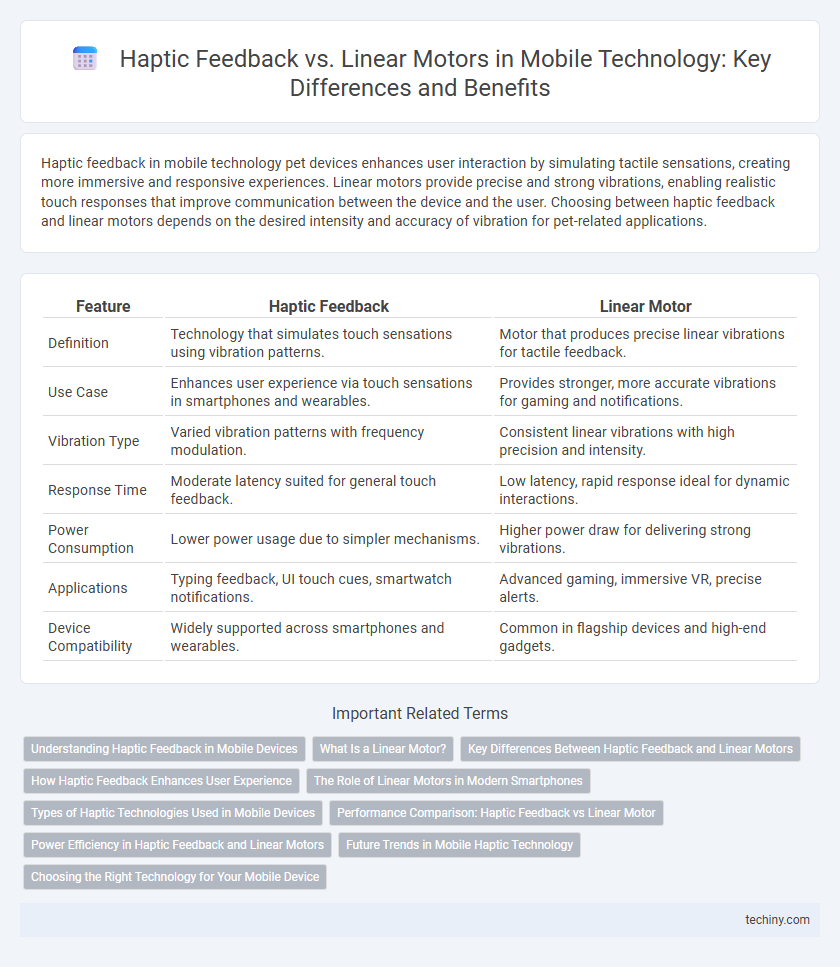Haptic feedback in mobile technology pet devices enhances user interaction by simulating tactile sensations, creating more immersive and responsive experiences. Linear motors provide precise and strong vibrations, enabling realistic touch responses that improve communication between the device and the user. Choosing between haptic feedback and linear motors depends on the desired intensity and accuracy of vibration for pet-related applications.
Table of Comparison
| Feature | Haptic Feedback | Linear Motor |
|---|---|---|
| Definition | Technology that simulates touch sensations using vibration patterns. | Motor that produces precise linear vibrations for tactile feedback. |
| Use Case | Enhances user experience via touch sensations in smartphones and wearables. | Provides stronger, more accurate vibrations for gaming and notifications. |
| Vibration Type | Varied vibration patterns with frequency modulation. | Consistent linear vibrations with high precision and intensity. |
| Response Time | Moderate latency suited for general touch feedback. | Low latency, rapid response ideal for dynamic interactions. |
| Power Consumption | Lower power usage due to simpler mechanisms. | Higher power draw for delivering strong vibrations. |
| Applications | Typing feedback, UI touch cues, smartwatch notifications. | Advanced gaming, immersive VR, precise alerts. |
| Device Compatibility | Widely supported across smartphones and wearables. | Common in flagship devices and high-end gadgets. |
Understanding Haptic Feedback in Mobile Devices
Haptic feedback in mobile devices utilizes small actuators to create tactile sensations, enhancing user interaction by simulating touch and vibrations. Linear motors, a specific type of actuator, produce precise and smooth vibrations through electromagnetic mechanisms, offering more nuanced and responsive feedback compared to traditional eccentric rotating mass (ERM) motors. Understanding the distinctions between haptic feedback technologies enables developers to optimize user experience with realistic touch sensations in smartphones and wearable devices.
What Is a Linear Motor?
A linear motor is an electromagnetic device that produces direct linear motion instead of rotational motion, commonly used in mobile technology for precise and responsive haptic feedback. Unlike traditional vibration motors, linear motors generate smoother and more accurate tactile sensations by directly controlling the displacement along a single axis. This technology enhances user experience in smartphones and wearable devices through refined vibration patterns and quick response times.
Key Differences Between Haptic Feedback and Linear Motors
Haptic feedback uses precise vibrations to simulate touch sensations, enhancing user interaction by providing tactile responses in devices like smartphones and gaming controllers. Linear motors generate smooth, linear motion through electromagnetic forces, primarily serving in applications requiring precise mechanical movement rather than tactile feedback. The key difference lies in haptic feedback's role in sensory communication versus linear motors' function in producing controlled physical displacement.
How Haptic Feedback Enhances User Experience
Haptic feedback significantly enhances user experience by providing tactile responses that simulate real-world interactions, improving immersion and precision in mobile technology. Unlike linear motors that primarily generate vibrations, advanced haptic engines deliver nuanced sensations such as texture differentiation and force feedback, enriching gaming, typing, and navigation activities. This sensory engagement not only boosts user satisfaction but also aids accessibility for users with visual impairments by offering intuitive, non-visual cues.
The Role of Linear Motors in Modern Smartphones
Linear motors play a crucial role in modern smartphones by enabling precise and responsive haptic feedback, enhancing user interaction through tactile sensations. Compared to traditional vibration motors, linear motors deliver faster, more accurate vibrations that simulate real-world touch experiences with varying intensities and frequencies. This technology improves notification alerts, gaming immersion, and overall device usability by providing nuanced feedback directly correlated to on-screen actions.
Types of Haptic Technologies Used in Mobile Devices
Haptic feedback in mobile devices primarily includes vibration motors and advanced linear resonant actuators (LRAs), which offer nuanced tactile responses. Traditional eccentric rotating mass (ERM) motors deliver basic vibrations, while LRAs produce precise, low-latency haptic effects by using a moving magnetic mass along a single axis. Emerging technologies like piezoelectric actuators further enhance haptic fidelity by generating localized vibrations without bulk, supporting immersive user experiences.
Performance Comparison: Haptic Feedback vs Linear Motor
Haptic feedback delivers precise vibrations that simulate tactile sensations, enhancing user interaction through localized and nuanced touch responses. Linear motors provide stronger, more immediate force feedback, resulting in a more immersive and dynamic experience, especially in gaming and virtual reality applications. In performance comparison, haptic feedback excels in detailed, subtle tactile cues, while linear motors outperform in intensity and response speed, making each optimal for different use cases in mobile technology.
Power Efficiency in Haptic Feedback and Linear Motors
Haptic feedback systems typically consume less power than linear motors due to their use of smaller, energy-efficient actuators like piezoelectric or voice coil motors. Linear motors require higher energy input to produce precise, strong vibrations or movements, making them less power-efficient in continuous or intensive applications. Optimizing power efficiency in haptic feedback involves balancing actuator type, vibration strength, and duration to extend mobile device battery life.
Future Trends in Mobile Haptic Technology
Future trends in mobile haptic technology emphasize enhanced tactile experiences through advanced linear motors that provide precise, localized vibrations. Integration of AI-driven adaptive haptics will allow devices to tailor feedback based on user behavior and environmental context. Emerging materials, such as electroactive polymers, promise more immersive and energy-efficient haptic responses for next-generation smartphones and wearables.
Choosing the Right Technology for Your Mobile Device
Selecting the right haptic feedback technology for your mobile device depends on the user experience goals and device design constraints. Linear motors provide precise, smooth vibrations that enhance tactile interactions, ideal for gaming and notifications requiring nuanced feedback. In contrast, traditional haptic feedback systems utilizing eccentric rotating mass (ERM) motors offer cost-effective solutions with less precision, suited for basic vibration alerts.
Haptic feedback vs linear motor Infographic

 techiny.com
techiny.com